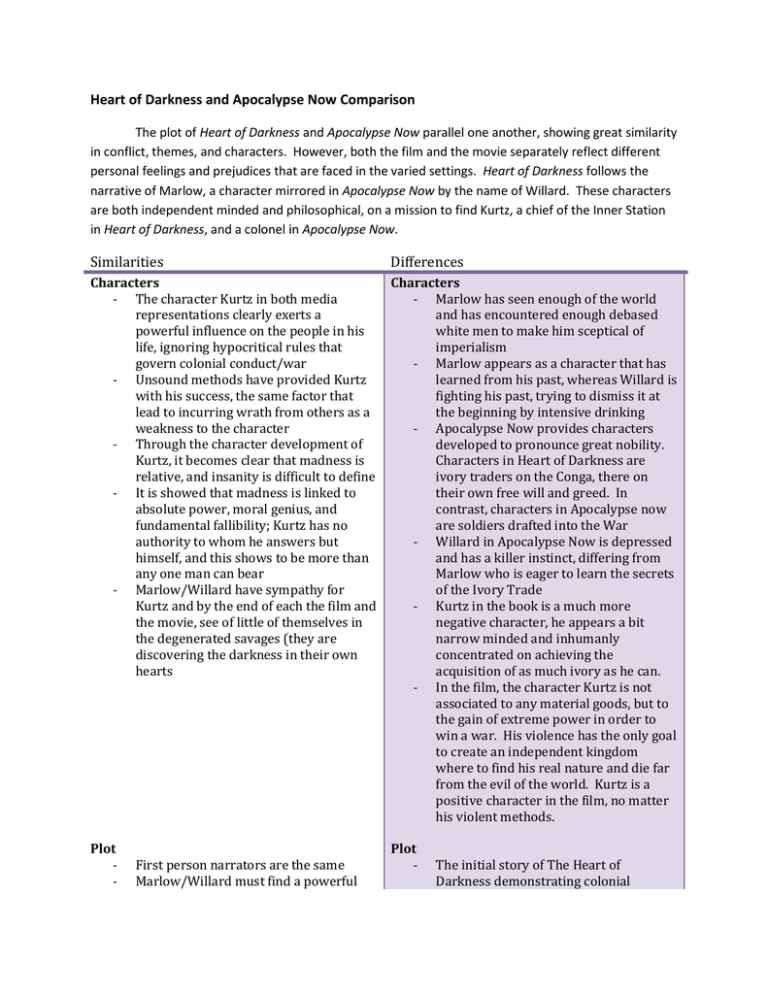Heart of Darkness and Apocalypse Now Comparison
advertisement

Heart of Darkness and Apocalypse Now Comparison The plot of Heart of Darkness and Apocalypse Now parallel one another, showing great similarity in conflict, themes, and characters. However, both the film and the movie separately reflect different personal feelings and prejudices that are faced in the varied settings. Heart of Darkness follows the narrative of Marlow, a character mirrored in Apocalypse Now by the name of Willard. These characters are both independent minded and philosophical, on a mission to find Kurtz, a chief of the Inner Station in Heart of Darkness, and a colonel in Apocalypse Now. Similarities Differences Characters - The character Kurtz in both media representations clearly exerts a powerful influence on the people in his life, ignoring hypocritical rules that govern colonial conduct/war - Unsound methods have provided Kurtz with his success, the same factor that lead to incurring wrath from others as a weakness to the character - Through the character development of Kurtz, it becomes clear that madness is relative, and insanity is difficult to define - It is showed that madness is linked to absolute power, moral genius, and fundamental fallibility; Kurtz has no authority to whom he answers but himself, and this shows to be more than any one man can bear - Marlow/Willard have sympathy for Kurtz and by the end of each the film and the movie, see of little of themselves in the degenerated savages (they are discovering the darkness in their own hearts Characters - Marlow has seen enough of the world and has encountered enough debased white men to make him sceptical of imperialism - Marlow appears as a character that has learned from his past, whereas Willard is fighting his past, trying to dismiss it at the beginning by intensive drinking - Apocalypse Now provides characters developed to pronounce great nobility. Characters in Heart of Darkness are ivory traders on the Conga, there on their own free will and greed. In contrast, characters in Apocalypse now are soldiers drafted into the War - Willard in Apocalypse Now is depressed and has a killer instinct, differing from Marlow who is eager to learn the secrets of the Ivory Trade - Kurtz in the book is a much more negative character, he appears a bit narrow minded and inhumanly concentrated on achieving the acquisition of as much ivory as he can. - In the film, the character Kurtz is not associated to any material goods, but to the gain of extreme power in order to win a war. His violence has the only goal to create an independent kingdom where to find his real nature and die far from the evil of the world. Kurtz is a positive character in the film, no matter his violent methods. Plot - Plot - First person narrators are the same Marlow/Willard must find a powerful The initial story of The Heart of Darkness demonstrating colonial - - - - man named Kurtz Venturing down a river, deeper into their tasks and the jungle The descriptive sections of the book can be compared to the film’s photography The helmsmen on both boats are killed by an attack from a native man with a spear Marlow and Willard both receive subjective information on Kurtz, allowing interpretation to promote the views of the corruption in war and colonial empires. General Manager mirrors the role of one of the generals in Apocalypse Now, both known for their rankings being due to their ability to stay alive, whether it be from avoiding bullet wounds or African diseases. The boats in both media representations pass their ‘last chance’ (inner post and last army post) where there boat is ambushed by escapees Theme/Other - Theme of human degeneration is apparent in both media representations - Kurtz’s character is used to explore Marlow’s/Willard’s character more in depth (Both are character foils to Kurtz) - Both media representations deal with civil humanity’s ability to be prepared for the known and unknown - White men dominate their respective crews and natives of the country they are visiting - The story of Marlow and Willard both exhibit moral confusion - In both stories there is the idea of the proverbial choice between the lesser of two evils - Marlow/Willard is forced to align himself with hypocritical colonial/wartime bureaucracy or the openly malevolent, rule-defying Kurtz - - injustice in a wild African frontier was applied to Apocalypse Now in the setting of a Vietnam War in order to demonstrate the opinion of a wrong political action and the brutality and senselessness of war. The same morals were applied to a different setting Willard is ordered to kill Kurtz Marlow and Willard act different to the perception and presence of Kurtz Marlow gains a great deal of information by watching the world around him and by overhearing others’ conversations, as when he listens from the deck of the wrecked steam manager of the Central Station and his uncle discussing Kurtz and the Russian trader. Willard gains information when he is debriefed for his mission. Marlow was stuck waiting at central port for boat parts, causing an intermediary part of the plot that allowed him to gather needed information about Kurtz. Theme/Other - Apocalypse Now breaches the edges of soldier sanity in the Vietnam War - Heart of Darkness explores issues surrounding imperialism and offers the harsh pictures of colonial enterprise - Apocalypse Now explores the corrupt nature of hierarchy in the army, an example being the general who continues to order the rebuilding of the bridge for the unwillingness to admit defeat, despite the sacrifice of young men - The Heart of Darkness more obviously plays on the metaphor of Darkness, of looking deeper inside you, and being unable to see that the human condition has implications.








